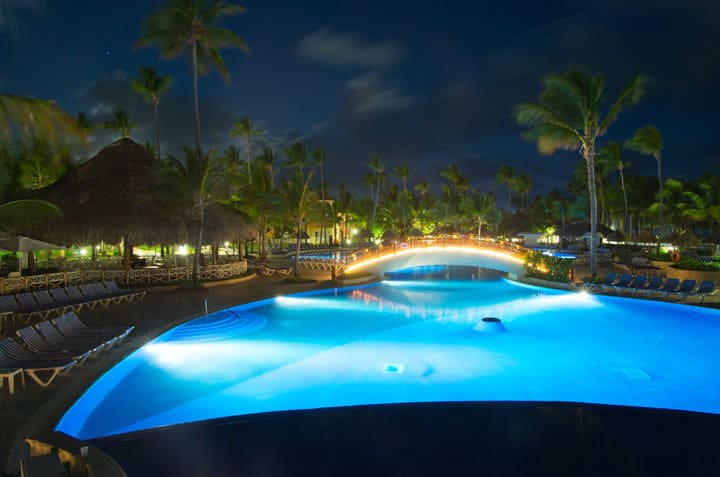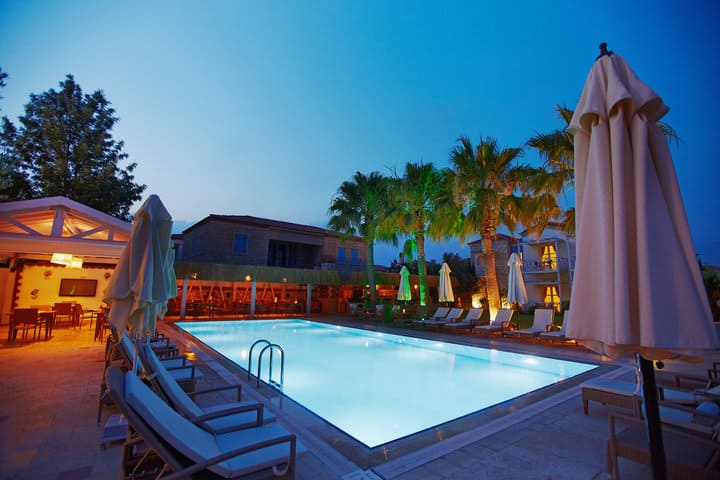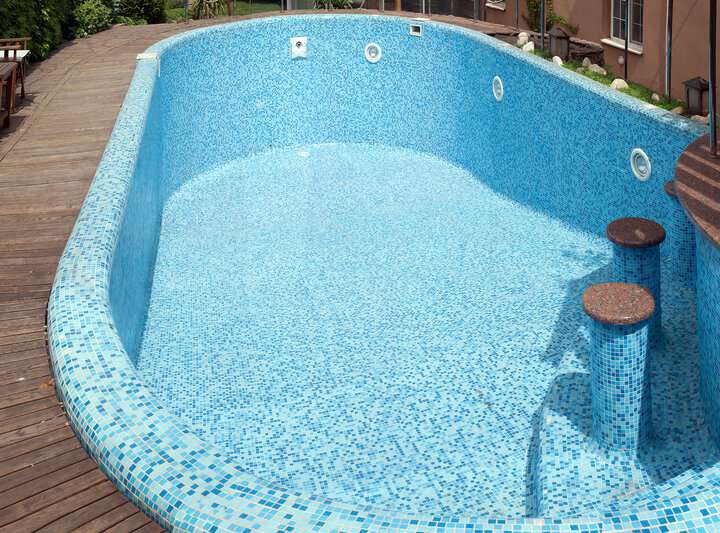Installing pool lights is not easy – I won’t sugarcoat it.
At least, it’s not if you’re going for hardwired lights installed underneath the water surface, which most people prefer to do.
Whether you’re doing it as a pool is installed or retrofitting it to an existing pool, there’s a lot of drilling work to lay the necessary conduits and ensure lights are grounded, and other metal items are bonded.
The results are worth it, but the last thing you want is to finish the work and realize you’ve installed too few lights or positioned them in a way that doesn’t look good.
You want to get this right at the planning stage.
Choosing in-ground pool lights depends on your pool’s size and shape. LEDs use lower electricity. In terms of the number of lights, a good rule for typical rectangular pools is to divide the length of the pool in feet by 8 and round up to the nearest number.
But there is a lot more to it than that for many people, so let’s take a look at:
- How to choose the pool lights you need
- How much electricity pool lights use
- Different options for pool lights
How To Choose Pool Lights?

If you’re looking to install pool lights inside your pool, there is a lot that you need to consider.
It would be straightforward to recommend the best pool light choices if all pools were the same, but they really aren’t. Here are some of the influencing factors:
Size
The pool size will not significantly affect the type of lights you choose, but it will impact how many you need.
Most pools are rectangular or at least longer along one side – square pools, or perfectly circular pools, are rare.
So you should only need lights along one side of your pool, as long as they’re powerful enough to illuminate all the way to the long opposite side.
The generally accepted rule is to divide the length of your pool, in feet, by 8 and then round up to the nearest number. For example, for a 30-foot pool, 30/8 = 3.75, so you would want four lights.
You’d then space them equally. Next, divide the pool length by the number of lights to get the space between them. So 30 feet, divided by 4, is 7.5 feet.
Install the first light half that distance from the edge – 3.75 feet – and then each light 7.5 feet.
This will give you an even glow along the edge of the pool.
Shape
The shape of your pool is, of course, a factor in deciding on your pool lights.
As I say, a rectangular pool is easy. But curved pools, or right-angle pools, are less so.
You can assume that pool lights have a beam of 60 degrees, so using a blueprint of a curved pool, you can work out the best placement to get maximum coverage along one curved wall.
With right-angle pools, the best thing to do is run lights along one long wall, with an additional light opposite where the pool is wider to provide even coverage.
Jandy are a pool light manufacturer, and their lighting design guide is helpful for other pool shapes too.
Finish
The finish of your pool will also impact your pool light choice, specifically the brightness. If your pool has a lighter finish, you won’t need as many lumens since the surface will reflect some of the light.
Depth
The general depth of your pool will have a negligible impact on your choice of pool light.
Provided you install the lights correctly and you don’t have an obscenely deep pool, lights will illuminate it all the way to the bottom.
Depth only becomes an issue when you have steps or a lounging area where a pool is less deep.
Here you can look at reducing the brightness of the lights, or changing styles to more strip lights, depending on the design. The reflections from a typical pool light will be too harsh if it’s a low-depth area.
Features
If your pool has any special features – a waterfall or maybe a central island – this will impact your choice of lights.
Waterfalls look great with strip lights running along the top, while central islands may necessitate extra lights on both sides of the pool due to the shadow they will cast.
I can’t make recommendations to cover every type of pool – they are never standard, and many are unique in their design.
The best thing you can do is bear all of these factors in mind, search Pinterest for inspirational imagery, and bear Jandy’s lighting design guide (and any others you find) in mind from a practical perspective.
How Many Lumens Should Pool Lights Be?
There is no regulation on how many lumens your pool lights should be.
While the National Electrical Code has a chapter dedicated to pool lighting with Article 680, this is dedicated to the safe wiring of lights – not the safe luminosity.
A Model Aquatic Health Code (MAHC) specifies that underwater lighting should have no less than 8 lumens per square foot of pool water surface area.
Yet this applies to public pools, not private ones. Still, if we use that guidance, a 30-foot by 15-foot pool would require 3,600 total lumens.
Multiply the length by the width to get the area, then multiply that by 8.
In reality, though, a private pool only needs a gentle glow. Again, if we go back to the Jandy guidelines, they don’t offer recommendations in lumens but by LED wattage. Their recommendations are:
| Pool Width (Colored Lights) | Pool Width (White Lights) | Recommended Bulb Wattage (LEDs) |
|---|---|---|
| Up to 12 feet | Up to 16 feet | 6 |
| 12 – 20 feet | 16 – 24 feet | 12 |
| 20+ feet | 24+ feet | 24 |
Some larger pool lights from other brands will be closer to 40 watts.
While they often don’t list their luminosity, they will advertise themselves as being 300-watt equivalent compared to halogens.
Do Pool Lights Use A Lot Of Electricity?

Most modern pool lights use LED tech, which doesn’t require much electricity to run.
As you can tell from the recommendations above, even wide pools only need bulbs that consume 24 watts.
Of course, not all pool lights are LED. Some are older incandescent, while halogen bulbs are also available to buy.
Here’s a look at typical wattages and consumption for the three bulb types. These are three bulbs that are relatively comparable in brightness.
| Bulb Type | Wattage | Hourly cost (assuming $0.14 per kWh) | Yearly cost, assuming 500 hours of use (5 hrs x 100 days) |
|---|---|---|---|
| LED | 40 watts | < $0.01 | $2.80 |
| Halogen | 300 watts | $0.04 | $21.00 |
| Incandescent | 500 watts | $0.08 | $37.50 |
What Are Other Pool Light Alternatives?

When talking about pool lights, we usually talk about the main circular lights installed under the water’s surface and recessed into the pool wall.
These usually are the default choice because once installed, they are relatively easy to maintain, give a gentle glow that fills the pool (so it is safe), and don’t get in the way of your swimming.
There are alternatives, though. Here’s a quick guide to some of your options:
Battery-Powered Pool Lights
Battery-powered pool lights work in the same way as regular pool lights, except they don’t need to be hardwired.
You wouldn’t use them alongside regular pool lights but as an easier alternative for adding to a pre-built pool.
However, they tend to have short battery life and may need recharging daily.
Pool Coving Strip Lighting
Depending on how your pool is built, you can add strip lighting to the pool’s coving or underside of the pool edge.
You’d need waterproof strips, but the glow around the pool’s edge can look incredible.
Also, it’s a good safety option for highlighting where the pool edges are at night.
Strip lights are less effective at illuminating the water. They would need to be used with a couple of submerged lights if you want to avoid the pool center in the shadow.
Overhead Lighting
Overhead lighting means any lights you could use above head height to illuminate your pool – it may be floodlights or string lights.
Floodlights are suitable from a safety perspective but depending on their beam angle, you may need multiple, and they won’t be effective at lighting below the water’s surface.
String lights are even less effective. They look charming, but they should be considered an additional option to pool lights, not an alternative.
Floating Lights
Floating lights sit on the water’s surface. They can do an excellent job from a safety perspective of casting some light into the water and illuminating the pool edges.
They have to be battery-powered, though – you can’t run the cable into the water – which means either recharging them or relying on solar, which may not charge the lights enough for a bright glow.
Also, they must be removed if you want to swim without bumping into them. Consider them more a novelty.
Final Words
There will never be an easy answer to choosing pool lights because pools can come in all shapes and sizes.
But follow the tips and general guidance I’ve given you. You should understand the principles of selecting pool lights, and you’ll find a solution that works for you.
If you’ve already installed your pool lights, are you happy with the glow they provide, or did you have to go back and add more or replace the lights with something less bright?


